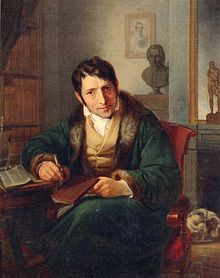|
Ludwig Börne
Karl Ludwig Börne (born Loeb Baruch; 6 May 1786 – 12 February 1837) was a German-Jewish political writer and satirist, who is considered part of the Young Germany movement.  Early lifeKarl Ludwig Börne was born Loeb Baruch on 6 May 1786, at Frankfurt am Main, to a Jewish family. He was the son of Jakob Baruch, a banker. His grandfather had been a government bureaucrat.[1] EducationBörne and his brothers were privately tutored by Jacob Sachs, and later by Rector Mosche. At age 14, he studied medicine with Professor Hetzel at Gießen. After a year, he was sent to study medicine at Berlin under a physician, Markus Herz, in whose house he lived.[2] At age 16, Baruch became infatuated by his patron's 38-year-old wife, Henriette Herz.[3] After her husband died in 1803, he expressed his adoration in a series of letters. When he enrolled at Halle University, she was influential in his boarding with Professor Reil. He studied constitutional law and political science at University of Heidelberg and Giessen. There, he received his PhD in 1809 with the dissertation Ueber die Geometrische Vertheilung der Staatsgebiete.[1] CareerOn his return to Frankfurt, now constituted as a grand duchy under the sovereignty of the prince bishop Karl von Dalberg, he received (1811) the appointment of police actuary in that city.[4] In 1814, he had to resign his post due to his ethnicity. Embittered by the oppression suffered by Jews in Germany, he took to journalism and edited the Frankfurt liberal newspapers Staatsristretto and Die Zeitschwingen.[4] Later lifeIn 1818, he converted to Lutheran Protestantism, changing his name from Loeb Baruch to Ludwig Börne.[5] From 1818 to 1821, he edited Die Wage, a paper distinguished by its lively political articles and its powerful but sarcastic theatrical criticisms. This paper was suppressed by the police, and in 1821, Börne took a pause from journalism and led a quiet life in Paris, Hamburg, and Frankfurt.[4] After the July Revolution (1830), he hurried to Paris, expecting to find society nearer to his own ideas of freedom.[6][7] Although to some extent disappointed in his hopes, he did not look any more kindly on the political condition of Germany; this lent additional zest to the brilliant satirical letters (Briefe aus Paris, 1830–1833, published Paris, 1834),[8] which he began to publish in his last literary venture, La Balance, a revival of Die Wage. The Briefe aus Paris was Börne's most important publication, and a landmark in the history of German journalism. Its appearance led him to be regarded as a leading thinker in Germany.[4] Death and legacyHe died in Paris in 1837.
Börne's works are known for brilliant style and for thorough French satire. His best criticism is to be found in his Denkrede auf Jean Paul (1826) – a writer for whom he had warm sympathy and admiration –, in his Dramaturgische Blätter (1829–1834), and the witty satire Menzel der Franzosenfresser (1837). He also wrote a number of short stories and sketches, of which the best known are the Monographie der deutschen Postschnecke (1829) and Der Esskünstler (1822).[4] In his first volume of Sigmund Freud's biography, Ernest Jones relates that "Böeme" [sic] was an especial favourite in Freud's adolescence, a half century later quoting many passages from the essay "The Art of Becoming an Original Writer", which clearly played a part in Freud's putting his trust in free association during psycho-analysis:
Two portraits of him, by the Jewish painter Daniel M. Oppenheim, are in the Israel Museum Collection. Bibliography
LegacyThe town of Boerne in the U.S. state of Texas, founded by German liberal immigrants (Forty-Eighters), is named after him. The town is a part of the San Antonio metropolitan area. The Börne Gallery at the Jewish Museum Frankfurt in Frankfurt, Germany is also named after him. References
Sources
External linksWikimedia Commons has media related to Ludwig Börne.
|
||||||||||||||||
